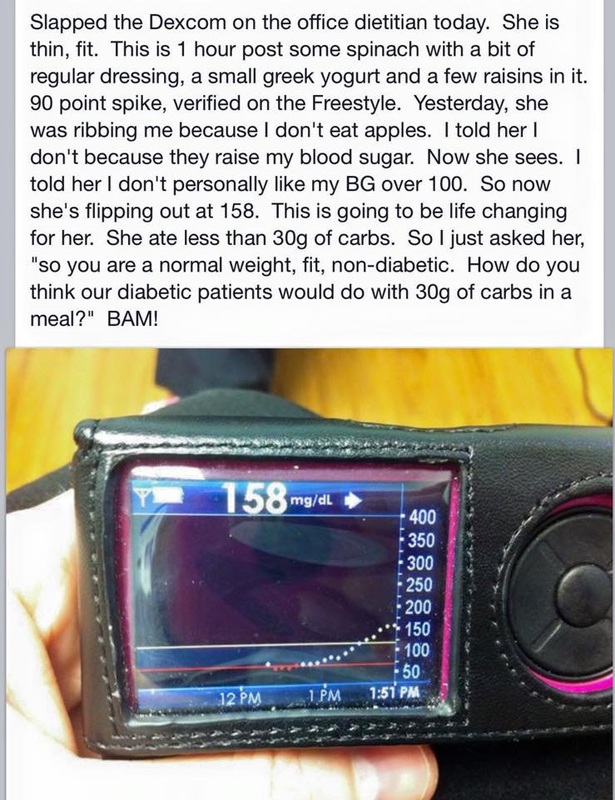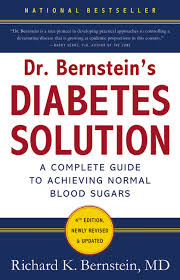I would like to start this blog post by first thanking Kelley, AKA the "Low Carb RN" for sharing this incredibly eye opening experience with us, so that we may share it with the world.
You see, most of us who are afflicted with diabetes (and know it) already know this truth. It is the rest of the population out there who do not seem to realize this, and this blog post is written for you.
You may be fit and slender. Some of you are at the gym every day. Some of you think that you can eat loads of carbs and that that is possibly even helping your metabolism and your physique. Some of you run marathons. Some of you are bodybuilders. Some of you power lift. Some of you compete in spartan races and "tough mudder" events. Some of you work in the healthcare field. Some of you are personal trainers, coaches and like the woman in the story… maybe you are even a even certified nutrition professional.
No matter. Diabetes is insidious and misunderstood by laypeople and healthcare professionals alike.
Listen up.
Did you catch that the photo caption? A thin, fit dietitian.
Like most of the rest of the world, we use the metric system in Canada… so henceforth I will talk about these numbers in metric terms. The conversion factor is 18 for those of you who are still using the old imperial system. 158 mg/dL equates to about 8.8 mmol/l. This is well beyond the level at which damage to the heart, kidneys, eyes and extremities such as the feet is thought to occur.
Just in case this is not gelling for you… this woman ate less than 30 g worth of carbs. This is much, MUCH less than the positively outrageous "not less than 130 g" of carbs (26 tsp) that the Canadian Diabetes Association is recommending that a diabetic eat.
I have seen fitness buffs who eat hundreds of grams of carbohydrates in a day and then justify it by running their asses off on stairs or on the treadmill or whatever hamster wheel piece of equipment that they choose. Yikes.
A normal healthy blood sugar to strive for all day, every day is approximately 4.6 mmol/liter (83 mg/dL). This equates to just a little bit less than 1 teaspoon (5 grams). Recall that in the previous paragraph I mentioned that the CDA recommends that a diabetic eat "no less than 130 g (26 tsp) of carbs in a day". No LESS than. All hope abandon, ye who enter here.
Anything more than this 1 tsp of sugar (carbs), and your body will have a strong hormonal response in an attempt to return your blood sugar levels to normal. Your life depends on your body's ability to do this. And, I really hate to tell you this… but, this rule holds true whether you are a first re-CrossFit athlete or an overweight couch surfer (insert pin into balloon here).
One of the most important investments that you can make in terms of your health is a blood glucose monitor. Currently, the Freestyle Freedom Lite is thought to be the most accurate. They are available for FREE at any pharmacy across Canada with the purchase of a bottle of strips. Bonus – most insurance companies will reimburse almost 100% of the the cost of the strips, even without a prescription.
Once you have the meter, what should you do? When should you be testing and what do the numbers mean?
To get a good grasp on what your blood sugar is actually doing, you should be testing it first thing in the morning upon arising (fasting) and before you eat or drink anything. You should then test at one hour and two hours after a meal or snack. If you really enjoy poking yourself, you can go one step further and test right before each meal as well.
Truly normal fasting blood sugar should be between 3.9 and 5 mmol/liter. That's right – those of you with blood sugars of 5.5 with doctors who are telling you that you are "okay" should be sitting up and taking a little bit of notice here.
Regardless of what they eat, the blood sugar of a truly normal person should be under 6.6 mmol/liter one or two hours after a meal, with most normal people being under 5.5 mmol/liter two hours after eating. Personally, I am a diabetic and I would not be at all pleased with a blood sugar of 6.6 two hours after a meal. I would consider it way too high and an indication that I ate something that caused it to spike.
If you are outside of those ranges then you have a choice to make. You can bury your head in the sand and wait for the inevitable, or you can be proactive. Speak to a knowledgeable healthcare professional or nutritionist (caveat emptor on this front… drop me a note and I will do my best to help you find someone in your area) about what you can do to bring your blood sugar numbers into the truly normal ranges. And please believe me… the numbers that are recommended by both the Canadian and the American Diabetes Associations are anything BUT optimal or healthy ranges.
Remember – there are thought to be 1 million UNDIAGNOSED diabetics in Canada (http://www.diabetes.ca/newsroom/search-news/canadians-urged-to-check-their-risk-of-diabetes).
Don't be one of them.
You see, most of us who are afflicted with diabetes (and know it) already know this truth. It is the rest of the population out there who do not seem to realize this, and this blog post is written for you.
You may be fit and slender. Some of you are at the gym every day. Some of you think that you can eat loads of carbs and that that is possibly even helping your metabolism and your physique. Some of you run marathons. Some of you are bodybuilders. Some of you power lift. Some of you compete in spartan races and "tough mudder" events. Some of you work in the healthcare field. Some of you are personal trainers, coaches and like the woman in the story… maybe you are even a even certified nutrition professional.
No matter. Diabetes is insidious and misunderstood by laypeople and healthcare professionals alike.
Listen up.
Did you catch that the photo caption? A thin, fit dietitian.
Like most of the rest of the world, we use the metric system in Canada… so henceforth I will talk about these numbers in metric terms. The conversion factor is 18 for those of you who are still using the old imperial system. 158 mg/dL equates to about 8.8 mmol/l. This is well beyond the level at which damage to the heart, kidneys, eyes and extremities such as the feet is thought to occur.
Just in case this is not gelling for you… this woman ate less than 30 g worth of carbs. This is much, MUCH less than the positively outrageous "not less than 130 g" of carbs (26 tsp) that the Canadian Diabetes Association is recommending that a diabetic eat.
I have seen fitness buffs who eat hundreds of grams of carbohydrates in a day and then justify it by running their asses off on stairs or on the treadmill or whatever hamster wheel piece of equipment that they choose. Yikes.
A normal healthy blood sugar to strive for all day, every day is approximately 4.6 mmol/liter (83 mg/dL). This equates to just a little bit less than 1 teaspoon (5 grams). Recall that in the previous paragraph I mentioned that the CDA recommends that a diabetic eat "no less than 130 g (26 tsp) of carbs in a day". No LESS than. All hope abandon, ye who enter here.
Anything more than this 1 tsp of sugar (carbs), and your body will have a strong hormonal response in an attempt to return your blood sugar levels to normal. Your life depends on your body's ability to do this. And, I really hate to tell you this… but, this rule holds true whether you are a first re-CrossFit athlete or an overweight couch surfer (insert pin into balloon here).
One of the most important investments that you can make in terms of your health is a blood glucose monitor. Currently, the Freestyle Freedom Lite is thought to be the most accurate. They are available for FREE at any pharmacy across Canada with the purchase of a bottle of strips. Bonus – most insurance companies will reimburse almost 100% of the the cost of the strips, even without a prescription.
Once you have the meter, what should you do? When should you be testing and what do the numbers mean?
To get a good grasp on what your blood sugar is actually doing, you should be testing it first thing in the morning upon arising (fasting) and before you eat or drink anything. You should then test at one hour and two hours after a meal or snack. If you really enjoy poking yourself, you can go one step further and test right before each meal as well.
Truly normal fasting blood sugar should be between 3.9 and 5 mmol/liter. That's right – those of you with blood sugars of 5.5 with doctors who are telling you that you are "okay" should be sitting up and taking a little bit of notice here.
Regardless of what they eat, the blood sugar of a truly normal person should be under 6.6 mmol/liter one or two hours after a meal, with most normal people being under 5.5 mmol/liter two hours after eating. Personally, I am a diabetic and I would not be at all pleased with a blood sugar of 6.6 two hours after a meal. I would consider it way too high and an indication that I ate something that caused it to spike.
If you are outside of those ranges then you have a choice to make. You can bury your head in the sand and wait for the inevitable, or you can be proactive. Speak to a knowledgeable healthcare professional or nutritionist (caveat emptor on this front… drop me a note and I will do my best to help you find someone in your area) about what you can do to bring your blood sugar numbers into the truly normal ranges. And please believe me… the numbers that are recommended by both the Canadian and the American Diabetes Associations are anything BUT optimal or healthy ranges.
Remember – there are thought to be 1 million UNDIAGNOSED diabetics in Canada (http://www.diabetes.ca/newsroom/search-news/canadians-urged-to-check-their-risk-of-diabetes).
Don't be one of them.




 RSS Feed
RSS Feed